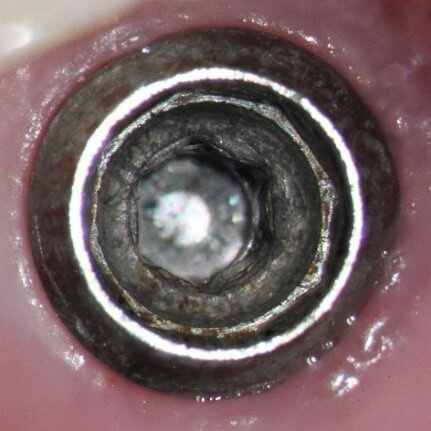The patient presented on referral from Dr. B and Dr. G for retrieval of a fractured screw in a tissue level implant in the #18 site. Originally, this implant was placed several years ago by a currently unidentified dentist in San Diego, who has subsequently left the state. There were numerous attempts, the patient believes seven, tried by three different dentists, all without success. After explaining the general protocols of fractured abutment screw retrieval, the implant was microscopically examined without the need of anesthetic, as the access was very good. The screw fragment was found to be well below the top of the implant threads but very mobile. A Type III case in my fractured screw treatment algorithm. The fragment was carefully spun out using a ¼ high speed surgical length round bur under 25x using the surgical microscope. This relatively straight forward save was possible for two critical reasons:
1. There was no noted implant damage resulting from prior rescue attempts, especially important regarding the implant threads, which would have locked the fragment. This is a very unusual finding after so many attempts, and very much appreciated.
2. Although this implant was listed as a Straumann RN tissue level implant, that is not the case as there is a hexagonal pattern broached through the threaded region, which ends in a hexagonal broach below the threads. Straumann implants do not have this internal feature. However, this space allowed the introduction of the ¼ round bur allowing for quick mobilization the fragment up and out, without nicking a thread. Initial review of several Straumann tissue level implant clones has not yet revealed which manufacturer implemented this modification to the original design. The technical team at Straumann will evaluate the below photographs to see if they have encountered this before. This is an interesting mechanical issue as I wonder how much thread contact is lost secondary to the broaching and when does this start to contribute to loss of preload?
After recovering the fragment, the implant was thoroughly cleaned, and a cotton pellet was place as no healing abutment was sent and none were available. The patient was referred back to Dr. G. for restoration. As there was no implant damage secondary to any of the recovery efforts, the implant prognosis has not decreased.












